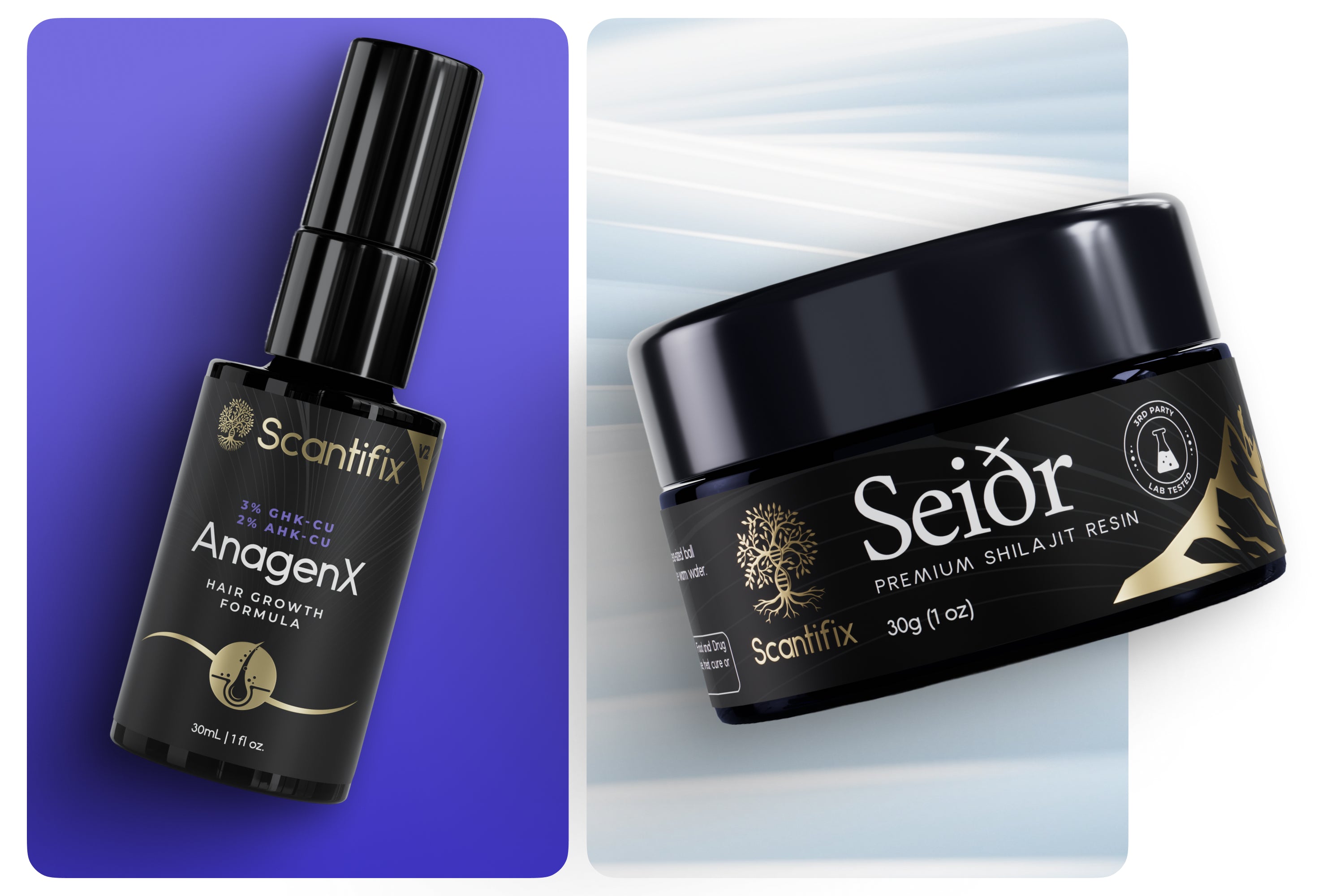Your skin barrier plays a central role in how your skin looks, feels, and functions. When it’s strong, your skin retains moisture, resists irritation, and recovers quickly when exposed to stressors. But when it’s compromised, it may lead to dryness, sensitivity, breakouts, or even signs of accelerated aging over time.
Let's explore what the skin barrier is, what weakens it, and how to repair and protect it over time. We’ll also explain how bioactive peptides can support skin barrier recovery from the inside out.
What Is the Skin Barrier?
The skin barrier is your body’s frontline defense against the outside world. It refers primarily to the stratum corneum, the outermost layer of skin composed of compacted skin cells (corneocytes) held together by lipids like ceramides, cholesterol, and fatty acids.
Skin cells and lipids work together to keep essential moisture in and harmful irritants, bacteria, and pollutants out. You can think of it as a protective wall.
This barrier also has a role in immune signaling and regulating inflammation. It helps skin cells communicate when there’s a threat, such as bacteria or injury, and controls how strongly the skin reacts. This makes it essential not just for cosmetic appearance, but for long-term skin resilience and health.
How to Know If Your Skin Barrier Is Compromised
When the skin barrier is disrupted, it loses its ability to hold in moisture and protect against external stress. You may notice:
-
- Persistent dryness that doesn't improve with moisturizers or hydrating products
- Redness, irritation, flaking, or a rough texture that doesn't resolve on its own
- A tight, burning, or stinging sensation—especially after washing your face
- Unexpected sensitivity to products you’ve used for a long time without issue
- A rise in breakouts, redness, or inflammation in areas that normally stay calm
- Skin that appears thinner, more reactive, or shows signs of premature aging
These symptoms are signs that your skin’s protective layer is no longer functioning properly and that it needs gentle, reparative support to recover. Recognizing these signs is the first step. But what actually causes the barrier to break down, and how can you start to repair it?
What Damages the Skin Barrier
Many common skincare habits, exposure to environmental stressors, and internal health factors can all compromise the skin barrier over time.
External Factors
-
- Over-cleansing or using harsh surfactants
- Over-exfoliating, especially with strong acids or scrubs
- Skipping moisturizers, particularly in dry or cold climates
- Sun exposure without SPF protection
- Pollution, allergens, or extreme weather changes
These external stressors physically disrupt the outermost skin layers or generate oxidative stress that weakens barrier function over time.
Internal Factors
-
- Lack of sleep, which reduces the skin’s ability to carry out nighttime repair and regeneration
- Chronic stress, which increases cortisol levels that interfere with skin recovery and immune balance
- Nutrient-poor diet, particularly one lacking essential fatty acids and antioxidants needed to maintain skin barrier lipids
- Hormonal changes, such as those related to stress, menstrual cycles, or pregnancy, which can alter skin hydration and oil production
- Underlying skin conditions, including eczema or rosacea, which are known to weaken barrier function
- Dehydration, which reduces moisture levels in the skin and affects its ability to retain water and stay balanced
These internal influences may not be as visible, but they can deeply affect the skin's ability to renew itself, retain moisture, and defend against daily stress.
When damage adds up, your skin struggles to produce enough ceramides, lipids, and structural proteins to maintain a healthy, functioning barrier. Understanding the causes of skin barrier damage allows you to make the appropriate adjustments to begin repairing effectively.
How to Repair the Skin Barrier
Repairing a damaged barrier starts with simplifying your skincare routine and using appropriate products. That means:
-
- Using mild cleansers that are free from alcohol, fragrance, and harsh surfactants like sodium lauryl sulfate.
- Applying rich moisturizers with ceramides, squalane, and fatty acids
- Layering in humectants like glycerin or hyaluronic acid to draw in hydration
- Avoiding potentially irritating actives like strong acids, retinoids, or high concentrations of exfoliants until the barrier is stable again
- Adding targeted treatments like peptides or niacinamide
- Always finishing with a broad-spectrum sunscreen to protect from UV-induced damage
These steps help restore the lipid matrix and prevent further moisture loss. To take repair and prevention even further, you can support your skin at a deeper level—helping rebuild the collagen framework, hydration pathways, and cellular communication systems that keep the barrier resilient over time. That’s where peptides come in.
The Role of Peptides in Skin Barrier Support
While moisturizers and lipids help seal in hydration at the surface, peptides work on a deeper, biological level by sending signals to the skin to repair and rebuild itself.
If you’re familiar with peptides, you likely know that they’re short chains of amino acids that act as messengers, telling your skin how to behave. In the context of skin barrier health, certain peptides can help:
-
- Strengthen the structural proteins like collagen and elastin which provide strength and elasticity for the skin barrier to function effectively
- Stimulate the production of glycosaminoglycans, molecules that hold water in the skin
- Calm inflammatory signals that interfere with repair and create a more favorable environment for healing
- Accelerate recovery after barrier damage or inflammatory flare-ups by encouraging cell renewal and tissue remodeling
By working beneath the surface to activate your skin's natural repair processes, peptides offer a unique approach to barrier support that complements surface-level protection. Let's look at specific peptides that excel at barrier support.
Top Peptides That Support a Healthy Skin Barrier
GHK-Cu (Copper Tripeptide-1)
GHK-Cu is one of the most studied peptides in regenerative skincare for its ability to bind and transport copper ions to skin cells, supporting wound healing, collagen production, and antioxidant activity. Here's how GHK-Cu may support the skin barrier:
-
- Collagen and elastin support: Boosts the synthesis of key structural proteins that strengthen skin’s foundational layers
- Hydration improvement: Increases glycosaminoglycans, which help the skin retain moisture
- Inflammation reduction: Lowers pro-inflammatory cytokines like IL-6 and TNF-alpha, creating a more favorable healing environment
- Tissue remodeling: Accelerates cellular renewal and repair in areas affected by damage or visible aging
(Pickart & Margolina, 2018).
Because copper helps strengthen the skin’s structure and defend against environmental stress, this peptide provides targeted support for repair and long-term skin barrier resilience.
Palmitoyl Peptides (Matrixyl and Syn-Coll)
Palmitoyl peptides are a class of signal peptides known for their ability to stimulate collagen production and reinforce skin structure. Two of the most well-studied are Matrixyl (Palmitoyl Pentapeptide-4) and Syn-Coll (Palmitoyl Tripeptide-5).
Research suggests they support barrier health in several ways:
-
- Epidermal thickening: Palmitoyl pentapeptide-4 has been shown to increase epidermal thickness, helping to strengthen the outermost layer of the skin (Lintner et al., 2002)
- Collagen support: These peptides stimulate collagen I and III synthesis, improving the dermal structure that supports barrier integrity (Katayama et al., 1993)
- Extracellular matrix renewal: By promoting production of collagen, elastin, and fibronectin, they reinforce the underlying skin matrix that keeps the barrier stable and resilient (Katayama et al., 1993)
Together, they help rebuild the deeper architecture that supports a healthy skin barrier from within.
How to Incorporate Peptides into a Barrier-Supportive Routine
Peptides work best when they’re paired with products that support their absorption and complement their effects. They don’t replace the basics. They enhance them by helping your skin rebuild from the inside while your skincare routine protects from the outside.
Here’s how to build a barrier-supportive ritual that maximizes the benefits of peptides:
-
- Cleanse gently: Start with a non-stripping cleanser to keep the barrier intact and prep skin for active ingredients.
- Layer hydrating ingredients: Use a water-based hydrator like hyaluronic acid before your peptide serum. This helps draw in moisture and supports ingredient delivery.
- Apply peptides: Use your peptide serum while skin is still damp. You can even formulate your own using raw peptides in a simple, minimal base.
- Seal with moisture: Follow with a ceramide-rich moisturizer to lock in hydration and reinforce the lipid barrier.
- Protect daily: Finish with a broad-spectrum sunscreen to shield vulnerable skin from UV-related barrier stress.
This approach gives peptides the environment they need to work effectively, while the rest of your routine maintains balance and protection at the surface.
How Scantifix Helps Support Skin Barrier Repair
We believe in working with the body’s biology, not against it. That’s why we offer peptides in their purest form, with every batch third-party tested for quality and consistency.
-
- Our peptides come in raw format, giving you the flexibility to formulate serums and solutions tailored to your skin’s unique needs.
- Whether you want to pair GHK-Cu with hyaluronic acid, or layer Matrixyl into a lipid-rich base, our peptides allow for full customization.
- And because our peptides are free of unnecessary additives, you get clean, science-backed ingredients.
With Scantifix, you can trust the peptides you're using are of the highest quality, purity, and integrity, so you can focus on restoring your skin barrier for long-term resilience and strength.
References:
Pickart, L., & Margolina, A. (2018). Regenerative and protective actions of the GHK-Cu peptide in the light of the new gene data. BioMed Research International, 2018, 7194543. https://pmc.ncbi.nlm.nih.gov/articles/PMC6073405/
Lintner, K., Mas-Chamberlin, C., & Mondon, P. (2002). Pentapeptide facilitates matrix regeneration of photoaged skin. Annales de Dermatologie et de Vénéréologie, 129, 1S401.
Katayama, K., Armendariz-Borunda, J., Raghow, R., Kang, A. H., & Seyer, J. M. (1993). A pentapeptide from type I procollagen promotes extracellular matrix production. Journal of Biological Chemistry, 268(14), 9941-9944. https://pubmed.ncbi.nlm.nih.gov/8486721/






Leave a comment
All comments are moderated before being published.
This site is protected by hCaptcha and the hCaptcha Privacy Policy and Terms of Service apply.